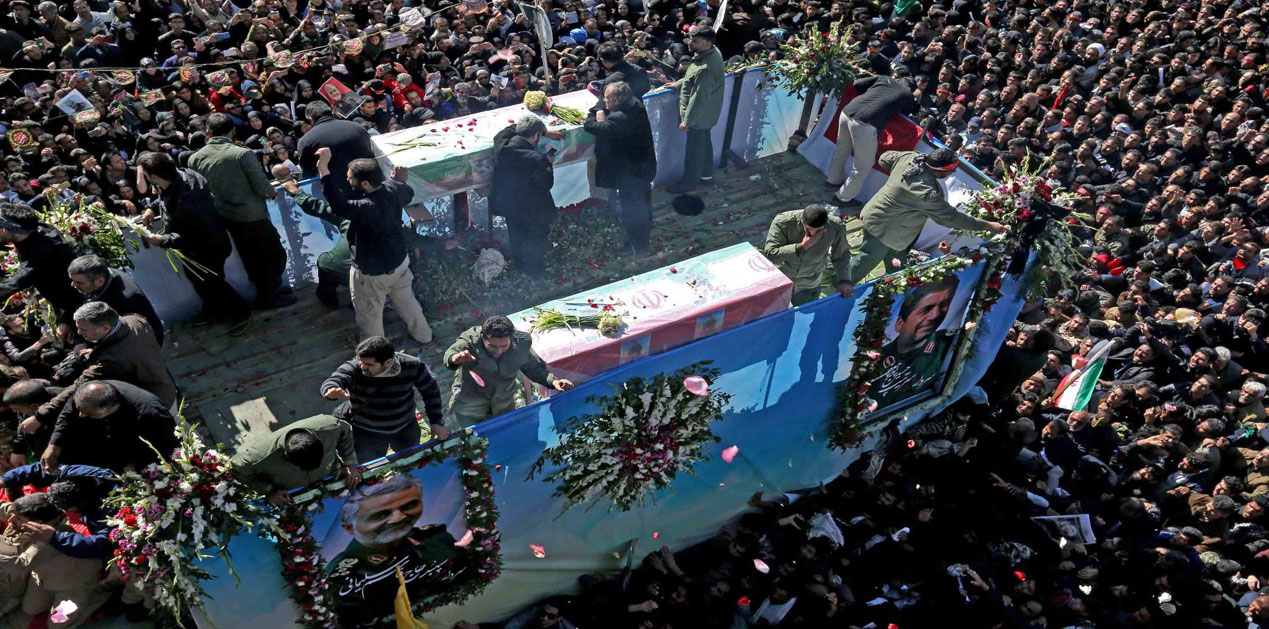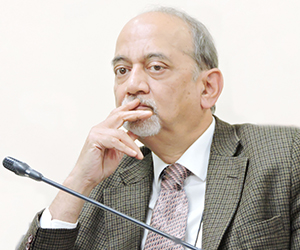Assassination of Major General Qasem Soleimani, commander of the Al Quds Forces in an American strike at Baghdad airport in the early hours of 3rd January sent shock waves in the region. Iran declared 3 days mourning and flags are being flown at half-mast. He was a symbol of Iranian resistance in Iran-Iraq war. His body was taken to Ahwaz, the border town occupied by Iraqi forces during Iran-Iraq war. It was taken thereafter to Mashad, Tehran and Qom and buried in his native place in Kerman. The last journey describes his association with defense of the revolution and the country. These were the two missions of the IRGC which he served faithfully. General Soleimani headed Al Qods, which is the external arm of Iranian Revolutionary Guards Corps (IRGC). Since then there was Iranian missile attack against US bases in retaliation. Though President Trump stated there would be further sanctions, there is no US counter-strike. No US life was lost in Iranian attacks.
American strike against Soleimani was carried out in Baghdad. The Iraqi government issued a statement describing US strike against Soleimani ‘flagrant breach of Iraq’s sovereignty’. The Iraqi Parliament has adopted a bill by a vote of 170-0 asking the Government to end any foreign presence on Iraqi soil. Sunni and Kurdish leaders abstained on the vote in the House, which has a total strength of 328 members. The resolution has a largely symbolic meaning. But it reflects internal tensions generated in that country, which had earlier seen attacks on Iranian consulates in Karbala and Najaf in November last.
The US statement described the strike as a ‘decisive defensive action to protect US personnel abroad’. The statement added that the strike was aimed at ‘deterring future attacks’ on US diplomats. The strike has come on the eve of Senate decision on President Trump’s impeachment. Nancy Pelosi, the House Speaker described the strike as a ‘disproportionate response’. Two leading US Presidential candidates – Biden and Bernie Sanders also criticized President Trump’s actions. Biden described it as ‘hugely escalatory’. Bernie sanders said this action brings US ‘closer to another disastrous war.’
The attack comes in the wake of December 27 attack on US led coalition bases in Iraq, which resulted in the death of an American defense contractor and severely wounding others. The next stage of escalation was US strikes on Kitaib-Hizbullah bases. This is a Shia militia group allied to Iran. This was followed by attack by a group of mourners on US Embassy in Baghdad. By some accounts, this provoked the memories of siege of US Embassy in Tehran in 1973.
This cycle of violence has ratcheted up tensions in the region. The Supreme Leader vowed severe revenge. President Trump said that any attack on US targets will attract American retaliation on 52 Iranian sites, including Iranian cultural sites. The number selected goes back to Iran hostage crisis in which 52 American diplomats were held captive. Hossein Dehgan, military advisor to the Supreme Leader said in a calibrated response that the Iranian retaliation would be on ‘US military targets.’
IRGC played a key role in defending Iran against Iraqi attack in the 80s. In April 2018, IRGC was placed on US sanctions list. A month later on 8th May, US withdrew from Iran nuclear deal. The US sanctions were re-imposed on Iran despite the fact that the country had complied with the terms of its nuclear accord with P5+1 as certified by IAEA. The E-3, including UK, France and Germany have stayed on with the accord along with Russia and China. The US also placed Iranian leadership including the Supreme Leader on the sanctions list. This ratcheted up tensions, and closed the doors for negotiations.
There were feelers by US to negotiate fresh agreement. President Trump stated last year that regime change was not the US objective. He also suggested direct meeting with President Rouhani, who was to visit New York for the UNGA session. President Trump did not retaliate after drowning of the US drone despite criticism by US hawks. Foreign Minister Javed Zarif said that Iran should not have to pay for the same horse again. He put the Iranian dilemma very well. If the multilateral accord endorsed by UNSC resolution 2231 can be re-opened, Iran could not be sure that new agreement will work. After Soleimani’s assassination, any chances of resuming negotiations are blocked.
Immediately after US strike, Brent benchmark price went up by 3.61 % on Friday morning to reach $ 68.64 per barrel. It has since gone up to $ 70.42 per barrel. As the markets re-open, fresh rounds of threats and counter-threats are expected to push up prices still further. The US withdrawal from the Iranian nuclear deal and re-imposition of sanctions last year had resulted in sharp hike in oil prices, which touched US $ 84 per barrel by October 2018. After US Congressional elections in November, the prices started coming down. The oil prices had started climbing again even before the assassination of Maj. General Soleimani. The price increase was driven by December 6 decision of OPEC plus consisting of OPEC and non-OPEC oil producers to cut crude oil production by 1.7 million barrel per day. Together with voluntary cuts announced by Saudi Arabia, this has led to reduction of 2.1 million barrels per day effective 1st January 2020. The latest incident has added geo-political tensions to economic factors pushing up the oil prices.
The assassination of General Soleimani is unlikely to change Iran’s regional policy. It will have an impact on the nuclear deal, though Iranian statement says that the cooperation with IAEA will continue. The Foreign Minister Zarif said that ‘as 5th and the final remedial step under paragraph 36 of Joint Comprehensive Plan of Action (JCPOA), there will no longer be any restriction on number of centrifuges’. However, the statement added that the step is reversible upon ‘Effective implementation of reciprocal obligations’. FM Zarif stressed that ‘Iran’s full cooperation with IAEA will continue.’
The EU foreign policy chief Josep Borell has invited Foreign Minister Zarif to visit Brussels to discuss de-escalation of tensions. According to a Financial Times report of today, German Foreign Minister Heiko Maas called for a meeting of EU Foreign Ministers stressing EU’s ‘overwhelming interest is to ensure that Iraq’s stability and unity does not fall victim to the current escalation.’
Since assassination of General Soleimani on 3th May, there was Iranian retaliation in terms of missile attacks on two American bases in northern and western Iraq in the early morning of 7th January. Foreign Minister Javed Zarif stated ‘Iran took and concluded proportionate measures in self-defence under Article 51 of UN Charter.’ This signaled there would not be further Iranian action at this stage. President Trump in nationally televised address said that US would impose further sanctions. This was a signal that US was not contemplating counter-retaliation against Iran after the missile attacks. This was a welcome departure from his earlier statement suggesting strong military retaliation, including against Iranian cultural site. President Trump also called for negotiating a new nuclear deal in place of the existing accord. He addressed his message to other partners in the nuclear deal, which include UK, France, Germany and Russia, China. He also addressed the Iranian people to come forward to negotiate the deal which would help them turn a new page.
Hormuz Strait carries nearly 20 percent of global oil trade. The Gulf accounts for nearly 70 percent of India’s energy imports. Gulf region also hosts a large Indian diaspora of more than 7 million Indians. India’s statement has advocated restraint. EAM who has just returned from visit to Washington and Tehran has spoken to FM Javed Zarif and Secretary of State Pompeo. Further ratcheting up of tensions will have major impact on Indian economy. There is urgent need to de-escalate. India can play a role.
(The paper is the author’s individual scholastic articulation. The author certifies that the article/paper is original in content, unpublished and it has not been submitted for publication/web upload elsewhere, and that the facts and figures quoted are duly referenced, as needed, and are believed to be correct). (The paper does not necessarily represent the organisational stance... More >>
Image Source: https://dynaimage.cdn.cnn.com/cnn/w_1600/https%3A%2F%2Fcdn.cnn.com%2Fcnnnext%2Fdam%2Fassets%2F200107105924-11-soleimani-funeral-kerman-0107.jpg











Post new comment